
Trumpeter 1/32 SBD-3 Dauntless
| KIT #: | 02242 |
| PRICE: | $129.95 MSRP |
| DECALS: | Three options |
| REVIEWER: | Tom Cleaver |
| NOTES: |

| HISTORY |
The SBD series was the first aircraft design attributed to Ed Heineman, who would go on to become the premiere designer of American carrier aircraft in a career that stretched from the SBD to the A-3 Skywarrior. The SBD began life as the BT, produced by Northrop Aircraft to the same 1934 BuAer design request that resulted in the SB2U Vindicator. Heineman’s design was much more modern than that of the Vought entry, owing much to Northrop’s Alpha, Beta, and Gamma designs, which at the time of their appearance were the most advanced American aircraft designs, utilizing innovative construction features that revolutionized the aircraft industry. Unlike the SB2U, which never developed a successful dive brake system to allow it to be a true dive bomber, the Heineman design had split perforated flaps which allowed a 90-degree dive under control without buffeting. 54 of these Northrop aircraft were purchased by the Navy in 1937, equipping Bombing Squadrons 5 and 6 aboard the “Yorktown” and “Enterprise” respectively.
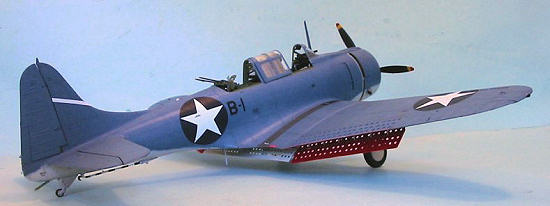 In January 1938, Jack
Northrop’s company was bought by Douglas Aircraft, becoming the El Segundo
Division. Heineman continued development of the BT-1, resulting in the BT-2
which appeared in 1938, using the much more powerful Wright R-1820 Cyclone, with
improved flight controls and a redesigned rudder. Now that the design was
produced by Douglas, it became the SBD-1, 57 of which were ordered for the
Marines, with 87 improved SBD-2s for the Navy. The definitive wartime SBD, the
SBD-3, entered production in March 1941. By paring 180 pounds out of the
airframe, Heineman was able to add self-sealing fuel tanks and armor plate to
the airframe without sacrificing overall performance. One important addition
was cockpit de-icing to keep the windshield clear when diving from colder high
altitudes to warmer low altitudes. By the end of 1941, Douglas was delivering
20 SBD-3s a month. After the outbreak of war, the company was able to increase
production to 11 a day by mid-1942, delivering over 1,600 SBD-3s during that
crucial year, in which the SBD-3 formed nearly the entire offensive power of
naval aviation in the most critical period of the war.
In January 1938, Jack
Northrop’s company was bought by Douglas Aircraft, becoming the El Segundo
Division. Heineman continued development of the BT-1, resulting in the BT-2
which appeared in 1938, using the much more powerful Wright R-1820 Cyclone, with
improved flight controls and a redesigned rudder. Now that the design was
produced by Douglas, it became the SBD-1, 57 of which were ordered for the
Marines, with 87 improved SBD-2s for the Navy. The definitive wartime SBD, the
SBD-3, entered production in March 1941. By paring 180 pounds out of the
airframe, Heineman was able to add self-sealing fuel tanks and armor plate to
the airframe without sacrificing overall performance. One important addition
was cockpit de-icing to keep the windshield clear when diving from colder high
altitudes to warmer low altitudes. By the end of 1941, Douglas was delivering
20 SBD-3s a month. After the outbreak of war, the company was able to increase
production to 11 a day by mid-1942, delivering over 1,600 SBD-3s during that
crucial year, in which the SBD-3 formed nearly the entire offensive power of
naval aviation in the most critical period of the war.
Dick Best at the Battle of Midway:
The truly-decisive naval battles throughout history have been decisive on a far wider range than merely the battlefield, or even the war in which the battle took place. At Salamis, the Athenian galleys not only defeated the Persian invasion fleet of Xerxes, but determined that Western civilization would continue to exist and develop as a world force. Trafalgar didn't merely mean that Napoleon would not be able to invade England and would thereby end his career in defeat - it meant Great Britain would be the dominant world power for next 125 years. So, too, the Battle of Midway, fought June 4‑6, 1942, did not merely mean that the United States would eventually win the Pacific War, but more importantly, as a result of that battle the U.S. would be the dominant Pacific power in all the years since.
In every great battle, there comes a moment when it seems the Gods of War have chosen the winner, when one side - despite its best efforts - cannot do other than lose, while the other sweeps on to victory. At Midway, this moment came at approximately 10 a.m. on the morning of June 4, 1942, when the 32 Douglas SBD Dauntless dive bombers of Bombing‑6 and Scouting‑6 from the U.S.S. "Enterprise," led by Air Group Commander LCDR Clarence Wade McCluskey, arrived over the Japanese carrier force at its single most vulnerable moment.
At that point, the United States was losing. The air forces on Midway had launched small strikes at the Japanese that had been unsuccessful in damaging the fleet. Having sent their first strike against the island at dawn, the Japanese prepared the second strike which would knock out what was left of Midway's aircraft and ground defenses, and allow the soldiers of the accompanying invasion fleet to take possession of the strategic mid-Pacific atoll and give Japan effective control of the Western Pacific.
Just
as Admiral Chuichi Nagumo, the Japanese commander, had given the order to launch
the second strike at Midway, a garbled message came from a scout plane that
reported at least one American carrier was operating northeast of the fleet. The
message was met with incredulity on the part of the Admiral and his staff - all
plans for the battle and invasion had been based on the presupposition that U.S.
carriers would not arrive at Midway until after the island had been
neutralized. For the Japanese,
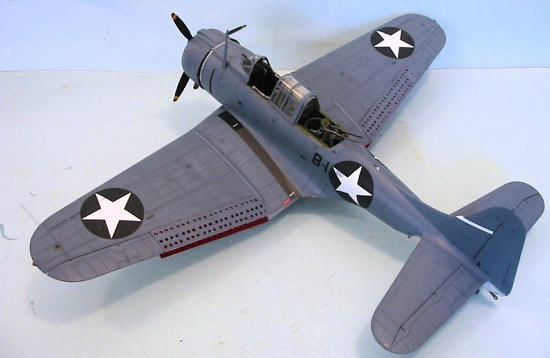 there
should be no carrier where reported. But if it was true, the Battle of the
Coral Sea had shown that the first strike would be decisive. Nagumo could
not risk
launching a second strike against Midway and allow the main enemy to make that
critical first strike. He immediately decided that the Kido Butai would
prepare to fight a fleet action.
there
should be no carrier where reported. But if it was true, the Battle of the
Coral Sea had shown that the first strike would be decisive. Nagumo could
not risk
launching a second strike against Midway and allow the main enemy to make that
critical first strike. He immediately decided that the Kido Butai would
prepare to fight a fleet action.
This meant unloading the high‑explosive bombs and reloading with armor‑piercing bombs and torpedoes. In the midst of the reload, another strike by Midway-based aircraft appeared to demonstrate the need to neutralize the known enemy, while a second garbled message from the scout seemed to negate the first. Relieved, Nagumo ordered a second reload to strike Midway. Halfway through, a third message from the scout reported two American aircraft carriers.
When the order came for the third reload, the exhausted deck crews on the four carriers left bombs lying on the deck next to fully‑fueled and armed aircraft as they hurried to rearm in the midst of an attack by American torpedo bombers from "Yorktown," "Enterprise" and "Hornet," in which the Japanese Combat Air Patrol shot down 32 of 36. The sacrifice of the torpedo bombers had drawn the CAP to wavetop level at just the worst moment. With the last of the American torpedo bombers shot down, Nagumo ordered his carriers to turn into the wind and commence launching the carrier attack strike.
As the first Zero accelerated down the deck of Nagumo's flagship, the lookouts screamed their warnings. High above, sunlight flashed on the canopies of American dive bombers as they commenced the single most important attack of the Pacific War. There was no time for the Japanese to do anything other than brace themselves.
Even with this tactical advantage, the "Enterprise" bombers almost blew the opportunity due to the fact that McCluskey - who previously commanded VF-6 before becoming Group Commander in May - was flying his first strike mission ever and was unfamiliar with dive bomber procedure, which called for McCluskey to take the lead squadron ‑ VS‑6 ‑ across the fleet to the far carrier of the two he had decided to attack, thus allowing the second squadron ‑ VB‑6 ‑ to make a simultaneous strike on the near carrier. McCluskey dove on the first carrier he saw, throwing off the coordination of the entire attack.
Leading Bombing‑6 was Lieutenant Richard H. "Dick" Best, Jr., Annapolis class of 1932 and a Naval Aviator since 1936. Best had transferred from flight leader with VF‑2, the elite "Flying Chiefs" squadron, to bombers in 1940, "because I knew we were going to war soon, and I wanted to make certain I was in a position to take the battle to the enemy." He had originally volunteered for torpedo bombers, seen then as the decisive strike squadrons of naval aviation, but did not have the seniority to keep a flight leader position in one of the in‑demand units; he took a transfer to dive bombers as the next-best choice.
As Best looked down at the Japanese fleet, he remembered the sight that had met his eyes the evening of December 7, 1941. "I thought about Pearl Harbor. We on Enterprise had been delayed a day due to bad weather, returning from taking a Marine fighter squadron to Wake Island. When I flew in to Ford Island that evening and saw the ships sunk, saw the airplanes destroyed, and learned of my friends who had been killed in the attack, I swore then I would do everything in my power to make them regret they had done that to us." The United States was about to be very lucky that Lieutenant Best had made the decision to take the assignment in dive bombers.
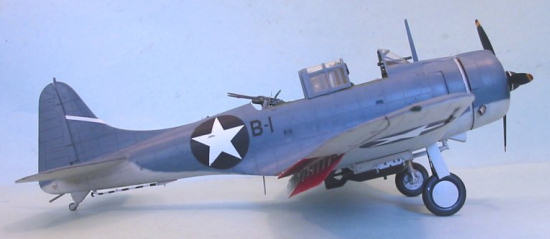 The first thing Best knew
of McCluskey's incorrect attack was when the Air Group Commander's SBD dove
directly in front of him. With the exception of Best's three‑plane lead
section, the other aircraft of VB‑6 dove with McCluskey and VS‑6. In an
instant, Best was left alone over the Japanese fleet with only two other dive
bombers - according to U.S. Navy tactical doctrine, this force was not only
insufficient, it was irrelevant. He led them to the far carrier and pushed over
in what would be recorded as the single most accurate, devastating dive bomber
attack by any pilot in the entire Second World War.
The first thing Best knew
of McCluskey's incorrect attack was when the Air Group Commander's SBD dove
directly in front of him. With the exception of Best's three‑plane lead
section, the other aircraft of VB‑6 dove with McCluskey and VS‑6. In an
instant, Best was left alone over the Japanese fleet with only two other dive
bombers - according to U.S. Navy tactical doctrine, this force was not only
insufficient, it was irrelevant. He led them to the far carrier and pushed over
in what would be recorded as the single most accurate, devastating dive bomber
attack by any pilot in the entire Second World War.
"I centered the sights on that big red rising sun painted on the deck. The flight deck was holystoned yellow and made an excellent target. I dropped my bomb at minimum altitude and as I pulled out I looked over my shoulder in time to see it hit just forward of the meatball." The other two members of the section, Lt(jg) Bill Kroeger and Ensign F. T. Weber, dropped their thousand‑pounders. Kroeger's hit amidships and Weber's on the stern, right amidst the fully-fueled and armed strike aircraft waiting to take off. "By the time I leveled off," Best recounted, "the carrier was afire from bow to stern."
In the years since, there has been controversy as to which carrier was hit by whom, and who hit what. In the book "God's Samurai," Mitsuo Fuchida states the first bomb did not strike "Akagi," but was a near miss. To this, Best replied that anyone in Fuchida's position would duck before the hit, and that the three explosions would have come so close together as to be almost indistinguishable. Even at age 90, Best was an intense man, and was very intense on the point that he did indeed hit his target.
At almost the same time the Enterprise bombers found the Japanese, the Yorktown bombers under CDR Max Leslie independently discovered the fleet and dove on a third carrier at almost the same minute that the Enterprise strike dove on the first two. The four carriers of Nagumo's fleet were the Akagi, the Kaga, the Soryu and Hiryu. Just prior to the American attack, Hiryu had turned to launch aircraft and was not in the central formation; therefore the three strikes had to be against Akagi, Kaga and Soryu. Best had no doubt who did what: "McCluskey and the rest of our group hit Kaga. I sank the Akagi. I was very familiar with Japanese ship identification and the ship I hit had its island on the port side instead of the starboard side. The only carrier there with that configuration was Akagi. The Yorktown bombers sank Soryu."
According to Best, the Americans won the battle almost in spite of themselves. "We could have saved the torpedo bombers with a combined strike, but McCluskey blew it. Mac flew right over what we had plotted as the likely Japanese course, and then flew on to the limits of range before he made that right turn he should have made 25 minutes earlier." Best always believed the young pilots who were lost to fuel starvation during the return might have had a better chance of making it back had they not had to add nearly 40 minutes of tight formation flying to what was already a maximum‑range strike. "I knew we had blown it, because I had it plotted and I was an excellent navigator, but we were maintaining radio silence and there was no way to catch up with Mac and convince him to turn, without burning too much fuel to make it to the target."
What Best didn't know at the time was that during the flight from Enterprise, he’d had an accident that would profoundly change his life. As they climbed above 10,000 feet, the crews went on oxygen, using a rebreather system similar to that used by submarine crews of the period for emergency escapes. Several pilots and gunners suffered failures of the system, and began lagging behind as they dropped to lower altitude. Best remained at altitude, breathing with increasing difficulty, but not connecting his own problem to that experienced by the others. Once the attack was made, he flew back to the fleet at lower altitude, so the problem was not again apparent.
The first he knew that all was not right was when he got down to his stateroom aboard Enterprise and coughed up a large amount of blood. He reported to sick bay, where he was put to bed while the doctors checked him over. Before anything could be resolved, scouts found the Hiryu, and a strike was put together from the surviving crews from the Enterprise and now-homeless Yorktown squadrons. Every pilot who could fly was needed. Best checked out of sick bay and made the mission, again leading Kroeger and Weber.
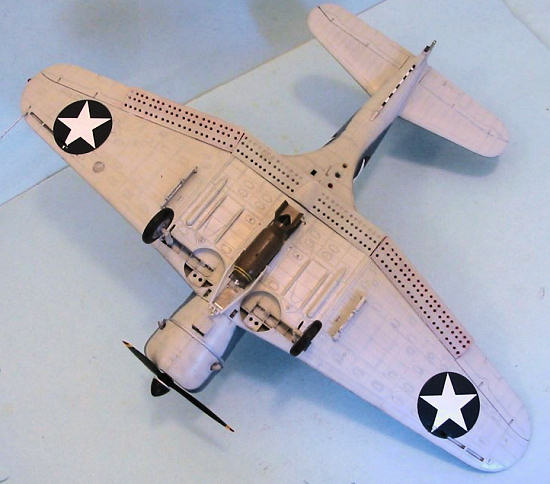 The mission was not flown
at high altitude, since by then it was known many of the oxygen sets were not
operating correctly. Best was in the second flight to dive on the
wildly‑evading carrier, and with this attack became one of very few men to ever
dive on and participate in the sinking of two enemy aircraft carriers in one
day. Unfortunately, Weber and his radioman were among those lost to Japanese
flak. Kroeger survived and was able to make a reunion in May 1988 at the
National Naval Aviation Museum in Pensacola, Florida, which was the first time
he and Best had seen each other since the Enterprise docked in Pearl
Harbor after the battle.
The mission was not flown
at high altitude, since by then it was known many of the oxygen sets were not
operating correctly. Best was in the second flight to dive on the
wildly‑evading carrier, and with this attack became one of very few men to ever
dive on and participate in the sinking of two enemy aircraft carriers in one
day. Unfortunately, Weber and his radioman were among those lost to Japanese
flak. Kroeger survived and was able to make a reunion in May 1988 at the
National Naval Aviation Museum in Pensacola, Florida, which was the first time
he and Best had seen each other since the Enterprise docked in Pearl
Harbor after the battle.
Best's landing back aboard Enterprise would be his last carrier trap, and the flight to strike Hiryu would be his last flight as a pilot, ever. "Many of my generation were exposed to tuberculosis as children, though it would remain dormant unless something happened to activate it. In my case, it was activated by the failure of the rebreather," he explained. Once back at Pearl Harbor, he was transferred to the U.S. Naval Hospital. The Navy promoted him to Lieutenant Commander and retired him from active service because of the disability, an action he fought hard to stop. "There were all kinds of men with worse problems than I had who remained on active duty during the war. I had participated in all the early war actions from Pearl Harbor to Midway with the exception of Coral Sea, and had experience the Navy could have used."
Several times after, Best would be close to death as a result of the disease, and was unable to find and keep steady employment because of this until shortly after the Korean War, when he was finally declared cured. For the next twenty years, he worked as the Chief Librarian for The Rand Corporation in Santa Monica. It was at the end of this period that he did something he was always far more proud of than he was of his efforts at Midway. “As librarian at Rand, I was the one who allowed Daniel Ellsberg to copy the ‘The Pentagon Papers,’ as a result of which the American people learned of the lies and mendacity that had gone into creating and sustaining that war, and eventually took the steps to stop it."
Following retirement and the death of his wife in the 1980s, Best lived alone in a beautiful book‑filled Spanish‑Mission style home in Santa Monica, which is where I visited many times over the five years of our friendship. Over the years he traveled across the country several weeks every month, speaking about Midway. In 1999, he said he had only two regrets: "My last cat died and I can't have another because I'm no longer in a position to promise him I would take care of him for the rest of his life, and I've lost enough of the upper and lower ranges of my hearing that I can't listen to music anymore."
Those of us fortunate to be friends of Dick Best were certain we'd gather in 2010 to celebrate his centenary. Unfortunately, he developed a persistent lung infection during the summer of 2001. That October, he went into the hospital complaining of chest pains. Four days later he slipped into a coma and died peacefully in his sleep on October 28, 2001, age 91. America lost a great hero and a true patriot that day.
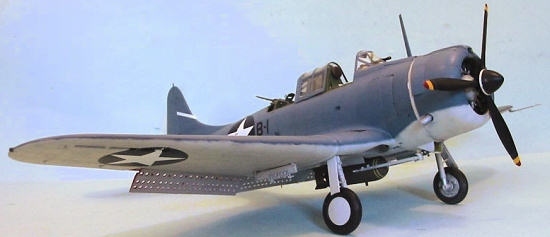 When I reviewed the SBD-2 kit
here recently, I called the Dauntless “the most successful dive bomber of the
war.” A correspondent challenged me privately, pointing to the achievements of
Rudel and the Stuka. I now reply: the Stuka was built and used to promote the
disaster known as Nazism, and Rudel was a moron who spent his entire life
believing in the evil that was Adolf Hitler. The Dauntless won the decisive
battles in the Pacific, which led directly to the destruction of fascism. Dick
Best dedicated his life to his country and believed with all his heart in our
highest ideals, and helped save us twice in our hour of need, at considerable
risk to himself both times. In my book, the Dauntless is the greatest
dive-bomber because of the ends it both served and created, and Dick Best was
truly aptly named.
When I reviewed the SBD-2 kit
here recently, I called the Dauntless “the most successful dive bomber of the
war.” A correspondent challenged me privately, pointing to the achievements of
Rudel and the Stuka. I now reply: the Stuka was built and used to promote the
disaster known as Nazism, and Rudel was a moron who spent his entire life
believing in the evil that was Adolf Hitler. The Dauntless won the decisive
battles in the Pacific, which led directly to the destruction of fascism. Dick
Best dedicated his life to his country and believed with all his heart in our
highest ideals, and helped save us twice in our hour of need, at considerable
risk to himself both times. In my book, the Dauntless is the greatest
dive-bomber because of the ends it both served and created, and Dick Best was
truly aptly named.
| THE KIT |
Essentially, the Trumpeter SBD-3/4/A-24A kit is the same as the SBD-1/2 kit, with the exception that it does not have the part for the SBD-1 cowl intake, and has the twin-gun rear mount and ammunition feed system, as well as the single-gun mount. Additionally, it has the alternative tail wheel for the land-based version, which can also be used if one builds a model of an SBD-3 based at Guadalcanal. The kit also includes a Hamilton-Standard prop for the SBD-4. The doors over the gun cover are not changed in size for the twin guns, though they were wider in the real airplane. I doubt most modelers will worry about this, since 99% of them won’t know there is a difference in the single and twin-gun storage, but for those who do so worry, rescribing this area will be necessary.
Decals are provided for the famous SBD-3 of VS-2 flown by Leppla and Liska at
the Battle of the Coral Sea, as well as a VB-2 airplane. Trumpeter seems not to
know what is what with these two airplanes, since it lists the VS-2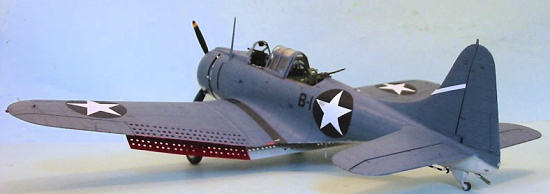 airplane as a “later” SBD-3 and shows it on the box art with the twin-gun
mount. They call the VB-2 airplane - which has the early-war oversize insignia
- a “late” SBD-3. In fact, both would be “early” airplanes and both would have
the single-gun mount. Inexplicably, rather than do an Operation Torch SBD-4 or
other combat veteran, markings are provided for a tri-color SBD-4 of a stateside
unit. Given that the decals are the wrong color, and that other details are
completely wrong regarding the national insignia, the only part of these decals
one would want to use are the stencils and the side numbers. The A-24A markings
are not much to write home about and provide “painted over” red center national
insignia. Modelers should opt to buy the much superior national insignia decals
from Yellow-Wings Decals, and I am informed they will also release a sheet of
markings specifically for the SBD-3 and SBD-4 that will include Operation Torch
national insignia.
airplane as a “later” SBD-3 and shows it on the box art with the twin-gun
mount. They call the VB-2 airplane - which has the early-war oversize insignia
- a “late” SBD-3. In fact, both would be “early” airplanes and both would have
the single-gun mount. Inexplicably, rather than do an Operation Torch SBD-4 or
other combat veteran, markings are provided for a tri-color SBD-4 of a stateside
unit. Given that the decals are the wrong color, and that other details are
completely wrong regarding the national insignia, the only part of these decals
one would want to use are the stencils and the side numbers. The A-24A markings
are not much to write home about and provide “painted over” red center national
insignia. Modelers should opt to buy the much superior national insignia decals
from Yellow-Wings Decals, and I am informed they will also release a sheet of
markings specifically for the SBD-3 and SBD-4 that will include Operation Torch
national insignia.
| CONSTRUCTION |
Construction for this model was exactly the same as for the SBD-2, with the
exceptions being that I did not use any parts that
 could
not be seen in the final result. This means I did not put any of the rear
fuselage parts for the life raft or the baggage compartment in, which resulted
in the fuselage going together so easily that no seams needed filling. For the
engine and cowling, I did not worry about “backside” details on the engine, and
did not use the engine mounts, since they are not needed structurally and cannot
be seen when the model is finished, unless the modeler has opted to either open
up a few panels or leave the cowling in clear plastic.
could
not be seen in the final result. This means I did not put any of the rear
fuselage parts for the life raft or the baggage compartment in, which resulted
in the fuselage going together so easily that no seams needed filling. For the
engine and cowling, I did not worry about “backside” details on the engine, and
did not use the engine mounts, since they are not needed structurally and cannot
be seen when the model is finished, unless the modeler has opted to either open
up a few panels or leave the cowling in clear plastic.
One
other thing I did differently from the first project was to asse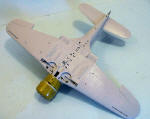 mble
the wings to the fuselage the same way I did with the Accurate Miniatures 1/48
kits. I did not assemble the wing as a sub-assembly, but rather glued each
upper wing part to the fuselage, which allowed me to work with the
wing-to-fuselage joint and get it nice and smooth without any seams or need of
filler. I then attached the lower wing part to the fuselage, then glued the
upper and lower wing parts together.
mble
the wings to the fuselage the same way I did with the Accurate Miniatures 1/48
kits. I did not assemble the wing as a sub-assembly, but rather glued each
upper wing part to the fuselage, which allowed me to work with the
wing-to-fuselage joint and get it nice and smooth without any seams or need of
filler. I then attached the lower wing part to the fuselage, then glued the
upper and lower wing parts together.
Building the model this way, I did not have to use any filler on any joints or cover any seams anywhere, a testament to the good design of this kit.
| COLORS & MARKINGS |
Painting:
I
opted to do Dick Best’s SBD-3 as he flew it on June 4, 1942 at Midway. Dick
told me that when VB-6 gave up their old SBD-2s after returning from the
Doolittle mission at the end of April, 1942, they received brand-new SBD-3s that
were as close to “factory
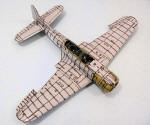 new”
as could be with having been shipped from California to Hawaii. As he described
them, “they were the cleanest airplanes I ever saw in the Navy.”
new”
as could be with having been shipped from California to Hawaii. As he described
them, “they were the cleanest airplanes I ever saw in the Navy.”
I used Gunze-Sangyo H-42 “Blue Grey” and Gunze-Sangyo H-51 “Light Gull Grey” for the camouflage colors. After pre-shading the model, I applied these colors in thin coats. I opted to put a very little bit of Light Gull Grey in the Blue Grey after painting the upper surface and going over it to give some tonal differentiation between metal surfaces and fabric surfaces, and some very slight sun-fading, which is probably not noticeable in photos, but keeps this large model from being as monochromatic as it would be otherwise in person.
Decals:
I used the Yellow Wings decals for the national insignia, and cut up the kit decals to get the “B-1". I also used the kit stencils. I went to a lot of trouble to track down numbers the right size on sheets in the decal dungeon to do the designators on the rudder, only to realize after doing it that I could have used the designators from the Yellow Wings sheet for BuNo 2106, since no one can see these anyway unless they are looking through a magnifying glass.
| FINAL CONSTRUCTION |
 I assembled and attached
the landing gear, then attached the twin-gun mount. I particularly like that
Trumpeter provides the ammo linkage for the rear guns. The canopy was
positioned open, and the prop was attached. I finished off by attaching all the
various navigation light fixtures. I left the airplane clean, the way it had
been described to me. I gave the model two coats of Xtracrylix Flat Varnish,
which does not dry dead flat, giving a more accurate rendition of the
factory-new paint, rather than the sun and salt-water weathered paint of an
airplane with longer service at sea than the few but vitally important days that
these airplanes saw service.
I assembled and attached
the landing gear, then attached the twin-gun mount. I particularly like that
Trumpeter provides the ammo linkage for the rear guns. The canopy was
positioned open, and the prop was attached. I finished off by attaching all the
various navigation light fixtures. I left the airplane clean, the way it had
been described to me. I gave the model two coats of Xtracrylix Flat Varnish,
which does not dry dead flat, giving a more accurate rendition of the
factory-new paint, rather than the sun and salt-water weathered paint of an
airplane with longer service at sea than the few but vitally important days that
these airplanes saw service.
| CONCLUSIONS |
I said it for the SBD-1/2 kit and I will say it here for this kit: these Trumpeter Dauntlesses are, in my opinion, the best kits of the SBD series available in any scale. They are accurate and easy to assemble if you follow the directions, and the result is a beautiful model. If the coming TBD has been designed by the same person who did this kit and the TBF Avenger, I will be in heaven.
July 2006
Copyright ModelingMadness.com.
Review kit courtesy of Stevens International.
If you would like your product reviewed fairly and fairly quickly, please contact the editor or see other details in the Note to Contributors.
Back to the Review Index Page 2017